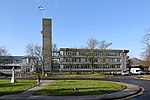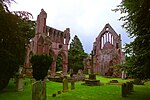St. Boswells railway station
1849 establishments in Scotland1969 disestablishments in ScotlandBeeching closures in ScotlandDisused railway stations in the Scottish BordersFormer North British Railway stations ... and 6 more
Pages with no open date in Infobox stationRailway stations in Great Britain closed in 1969Railway stations in Great Britain opened in 1849Scotland railway station stubsSt BoswellsUse British English from May 2017

St Boswells railway station was a railway station that served the villages of Newtown St Boswells and St Boswells, Scottish Borders, Scotland from 1849 to 1969 on the Waverley Route. Although named after the larger village of St Boswells, the station was situated in Newtown St Boswells, located 1 mile (1.6 km) to the northeast.
Excerpt from the Wikipedia article St. Boswells railway station (License: CC BY-SA 3.0, Authors, Images).St. Boswells railway station
Waverley Place,
Geographical coordinates (GPS) Address Nearby Places Show on map
Geographical coordinates (GPS)
| Latitude | Longitude |
|---|---|
| N 55.5772 ° | E -2.6724 ° |
Address
Waverley Place
TD6 0RS
Scotland, United Kingdom
Open on Google Maps










